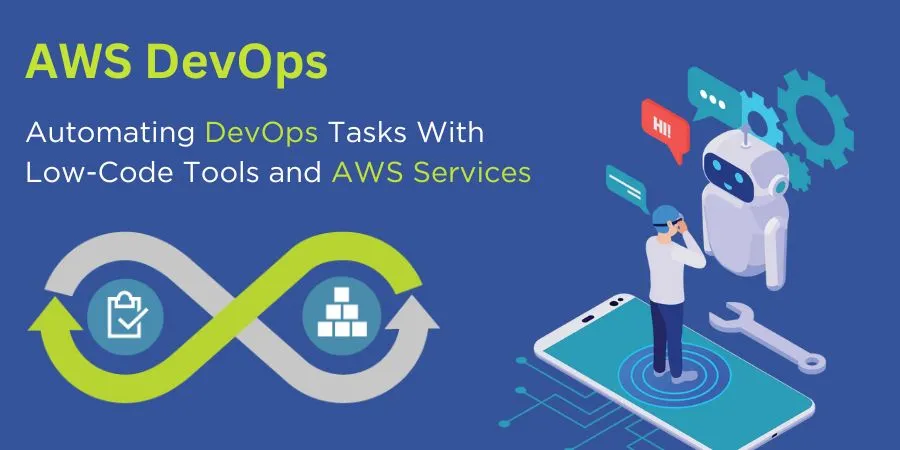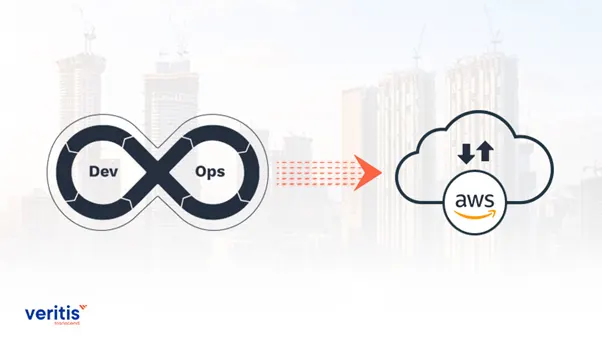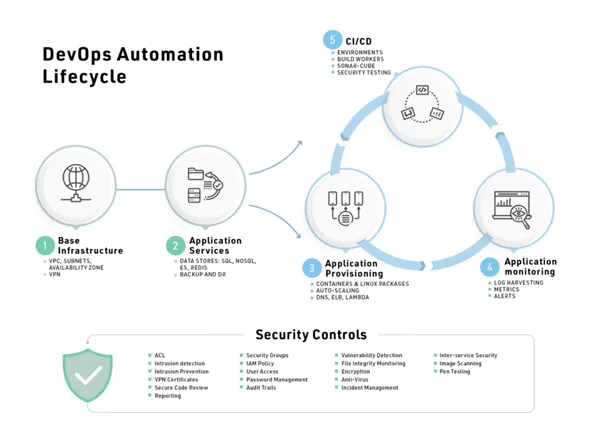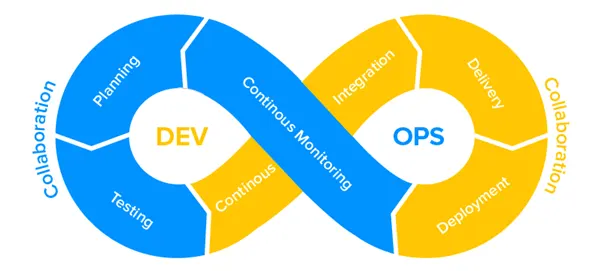
Introduction: Redefining DevOps with Low-Code and AWS Excellence

Image source: https://www.veritis.com/blog/devops-on-aws-an-introduction-on-how-to-integrate-seamlessly/
Imagine a world where creating software is like putting together building blocks, and the cloud is an enchanting space where everything happens seamlessly. This is the exciting realm we step into when we explore the wonders of automating DevOps tasks using simple tools and the power of Amazon Web Services (AWS).
Low-Code Tools: Simplifying Software Building
Think of low-code tools as the friendly helpers in the world of making computer programs. These tools simplify application creation, allowing anyone, regardless of coding expertise, to build applications effortlessly. Rather than dealing with complex code, you can simply click and drag elements to create your application—it's as straightforward as that!
Unlocking the Essence of Low-Code Tools: Key Features Unveiled

1. User-Friendly Interface:
Highlight: Low-Code tools boast interfaces designed for simplicity, enabling non-developers to create applications effortlessly.
2. Visual Development:
Highlight: Visual modeling takes center stage, resembling a visual puzzle where users design applications intuitively with minimal coding.
3. Automation:
Highlight: Repetitive tasks find a new ally in automation within Low-Code tools, streamlining processes and saving valuable time.
AWS Services: The Enchanting Cloud for Developers
AWS, or Amazon Web Services, is like a magical cloud for developers. It's a place where they can organize, control, and expand their applications. AWS Devops consultants provides a variety of services that completely change how developers work, making their experience much better and more efficient. It's like a wizard's spell that transforms the whole process of developing and managing applications.
Revealing Key AWS Services: The Heart of Cloud Magic

Lambda:
Highlight: A versatile function allowing code execution without server concerns, providing flexibility for varying application needs.
CodePipeline:
Highlight: An expert coordinator, guaranteeing smooth and automated transitions from code creation to application release.
CloudFormation:
Highlight: An expert developer transforming framework components into code, quickly executing tasks per user/client guidelines.
AWS and Low-Code Tools: A Perfect Duo for DevOps Automation

Image source: https://duplocloud.com/white-papers/devops/
Imagine AWS (Amazon Web Services) and Low-Code tools joining forces like a dynamic duo to simplify and automate DevOps tasks. Here's how this powerhouse team collaborates to make the DevOps process smoother and more efficient:
1. Streamlined Development with Low-Code:
- Low-Code's Role: Low-Code tools provide a user-friendly platform for creating applications with minimal manual coding.
- Collaboration with AWS: AWS work together with Low-Code platforms, letting developers create applications by dragging and dropping elements.
2. Serverless Computing with AWS Lambda:
- AWS Lambda's Role: Lambda let developers run code without dealing with servers.
- Low-Code tools can make things happen with Lambda, doing tasks automatically, so developers don't need to get into the nitty-gritty of server stuff. It's like making your computer do the work for you!
3. Continuous Integration and Delivery with AWS CodePipeline:
- AWS CodePipeline's Role: CodePipeline is like your tech assistant, making sure everything happens automatically when you change your code until your application is ready for use.
- Low-Code Collaboration: Low-Code tools and CodePipeline, ensures that changes made in the Low-Code environment is smooth through the development pipeline.
4. Infrastructure as Code with AWS CloudFormation:
- AWS CloudFormation's Role: CloudFormation is like an architect, transforming framework into code and managing it as such.
- Low-Code Collaboration: With Low-Code, you can easily add applications to CloudFormation templates. This makes it simple to deploy and manage both the framework and your application code together.
5. Easy Monitoring with AWS CloudWatch:
- AWS CloudWatch's Role: CloudWatch keeps an eye on the performance of AWS resources and applications.
- Low-Code Collaboration: Low-Code apps can use CloudWatch to keep an eye on things, making sure you can easily check how well they're doing.
6. Simplified Database Management with AWS RDS:
- AWS RDS's Role: RDS takes care of database management, handling backups, updates, and scaling.
- Low-Code Collaboration: Low-Code applications can easily connect to AWS RDS, making smooth database interactions without needing manual setup.
7. Cross-Platform Compatibility with AWS Services:
- AWS's Role: AWS offers a variety of services for different functionalities, ensuring cross-platform compatibility.
- Low-Code Collaboration: Low-Code tools can easily use different AWS services, fitting into various platforms without any hassle.
8. Collaboration and Scalability with AWS Organizations:
- AWS Organizations' Role: Organizations bring together the control and oversight of numerous AWS accounts in one place.
- Low-Code Collaboration: Teams creating Low-Code applications in different accounts can work together easily using AWS Organizations. This ensures scalability and efficient sharing of resources.
Real-Time Examples of Automated DevOps with AWS and Low-Code Tools: A Glimpse into the Future

Image source: https://www.keitaro.com/insights/2021/08/10/ci-cd-pipelines-and-software-delivery-a-concise-overview/
1. Automated Continuous Integration and Delivery (CI/CD):
Scenario: A team is using a Low-Code platform to build applications. They set up AWS CodePipeline to spot any changes in the Low-Code system. When there are code changes, CodePipeline automatically kicks off the process to build, test, and launch the application, all thanks to AWS Lambda functions. This approach directly impacts key Accelerate metrics, such as deployment frequency and lead time for changes.
Benefits: Developers put their focus on coding, and the CI/CD pipeline takes care of everything, automating the whole process from development to deployment.
2. Serverless Function Deployment:
Scenario: With a Low-Code tool, a developer builds a serverless function. The Low-Code platform seamlessly integrates with AWS Lambda, making it easy to deploy the function without any manual setup.
Benefits: Serverless functions are deployed effortlessly, and the Microservices developers doesn't have to worry about setting up or managing servers.
3. Infrastructure as Code (IaC) for Scalability:
Scenario: For a Low-Code application that needs to grow, the platform creates AWS CloudFormation templates. These templates lay out the needed AWS resources. When there are changes in the application requirements, CloudFormation takes care of the updates automatically.
Benefits: Scalability is achieved effortlessly by adjusting settings in the Low-Code environment, and AWS CloudFormation makes the necessary changes in the framework.
4. Monitoring and Alerts Integration:
Scenario: When a Low-Code application goes live on AWS, it's connected to AWS CloudWatch using the Low-Code platform. CloudWatch alarms are then set up to send alerts whenever certain performance levels cross predefined thresholds.
Benefits: The application gets monitored in real-time automatically, and teams get alerts about potential issues without needing to step in manually.
5. Cross-Platform Compatibility:
Scenario: A Low-Code application is designed to run on multiple platforms. AWS services, such as AWS Lambda and Amazon RDS, are utilized to ensure cross-platform compatibility.
Benefits: The application seamlessly adapts to different platforms, leveraging AWS services consistently across environments.
6. Database Management Automation:
Scenario: In a Low-Code application, the interaction with an AWS RDS-managed database is smooth. AWS RDS takes care of tasks like scaling and maintenance automatically, ensuring the application can grow without needing manual interference.
Benefits: Developers concentrate on the application's logic, while routine database management tasks are handled automatically by AWS RDS.
7. Collaborative Development with AWS Organizations:
Scenario: Several development teams, each utilizing a Low-Code tool, work together on a project. AWS Organizations is used to bring together the management of AWS accounts and resources, ensuring smooth collaboration.
Benefits: Teams can operate independently in their Low-Code setups, and AWS Organizations simplifies the sharing and management of resources across the board.
These real-time examples serve as windows into the realm where AWS and Low-Code tools join forces, automating DevOps intricacies.
Elevating the Developer Experience: How Does the Synergy Between AWS and Low-Code Tools Shine?
1. Continuous Harmony:
Developers code effortlessly, while AWS CodePipeline and Low-Code unite to automate the process from code creation to deployment. Continuous Integration and Delivery become a harmonious dance.
2. Serverless Simplicity:
Create serverless functions effortlessly with Low-Code. AWS Lambda steps in, managing deployment details seamlessly without any manual effort.
3. Scalable Elegance:
AWS CloudFormation and Low-Code blend to create a masterpiece of scalability. Changes trigger automatic updates, turning framework into code effortlessly.
4. Alerts in Tune:
Low-Code smoothly links up with AWS CloudWatch for real-time monitoring. Alarms set through the platform act as vigilant guards, keeping an eye out for potential issues.
5. Versatility Showcase:
In a world of varied platforms, AWS services and Low-Code work together. The application effortlessly adjusts, highlighting the versatility achieved through cross-platform compatibility.
6. Database Choreography:
AWS RDS and Low-Code execute a symphony of database management. Scaling and maintenance tasks are handled seamlessly, freeing up developers to concentrate on crafting the application narrative.
7. Unified Collaboration:
Multiple teams, each using a Low-Code tool, collaborate seamlessly. AWS Organizations brings together resource management, fostering an efficient symphony of collaboration.
Step into the magical collaboration of AWS and Low-Code, where complexity transforms into simplicity, and DevOps becomes a symphony of efficiency and collaboration.
Peering into the Future: How Will Automated DevOps Shape Tomorrow's Landscape?

Image source: https://appinventiv.com/blog/devops-for-mobile-app-development/
The upcoming era of Automated DevOps signals a significant change in how software development and IT operations work together to enhance and simplify processes. Let's take a sneak peek into what the future might bring:
1. Increased Efficiency:
Automation is presently simplifying routine tasks in DevOps software, reducing the need for manual work. The future holds a substantial transformation as advanced AI and machine learning step into the forefront. DevOps procedures are poised to become highly intelligent systems, foreseeing and proactively addressing issues before they escalate. This foresees an unparalleled boost in efficiency, underscoring the pivotal role of automation in shaping a more streamlined and proactive DevOps landscape.
2. Continuous Integration and Deployment Evolution:
In the current landscape, CI/CD pipelines are instrumental in automating code integration and deployment. Looking ahead, envision the emergence of self-healing pipelines that dynamically adjust, autonomously optimize resources, and proficiently manage intricate deployments. This signals a transition toward more intelligent and dependable CI/CD processes.
3. AI-Driven Operations:
At present, AI is responsible for monitoring and making basic decisions. In the future, anticipate AI algorithms autonomously managing tasks, making real-time decisions, and constantly learning from system behavior to enhance performance and security. This signifies a move towards a more self-sufficient AI, propelling continuous improvements in efficiency and safety.
4. DevSecOps Integration:
In the current scenario, security plays a crucial role in DevOps, often termed as DevSecOps. Moving forward, the future anticipates the integration of automated security measures seamlessly into the development lifecycle. AI-driven threat detection and automated responses are poised to become standard practices, establishing a proactive and comprehensive security framework for software development.
5. Advanced Data Management:
Data is crucial, but managing it can be complex.
In near future, Automated DevOps will leverage advanced data management tools, optimizing data flows, ensuring compliance, and seamlessly integrating data analytics into the development pipeline.
6. Serverless Dominance:
In the present era, Serverless architectures are gaining popularity.
Serverless will be the norm, reducing infrastructure management to near-zero and allowing developers to focus solely on code and application logic.
7. Edge Computing Integration:
Edge computing is on the rise.Automated DevOps will seamlessly extend to the edge, managing applications and services on distributed networks, providing low-latency experiences.
8. Holistic Observability:
Monitoring and observability are essential for DevOps.Advanced analytics and AI-driven observability will provide holistic insights into system health, application performance, and user experiences in real-time.
9. Autonomous DevOps Teams:
DevOps teams collaborate closely but involve manual decision-making. Teams will focus more on strategic planning and innovation, as routine decisions, optimizations, and issue resolutions are handled autonomously by AI-driven systems.
10. Enhanced Collaboration with Low-Code Tools:
Low-Code tools simplify development. Integration with Automated DevOps will make Low-Code even more powerful, enabling rapid development, effortless scalability, and seamless integration with the automated pipeline.
In Essence: The Future of Automated DevOps
The future of Automated DevOps will be characterized by unparalleled efficiency, advanced intelligence, and seamless collaboration between code developers and automated systems. As technology evolves, so will the capabilities of Automated DevOps, shaping a landscape where innovation and efficiency go hand in hand.
Conclusion: Harmonizing DevOps with AWS and Low-Code Brilliance
AWS and Low-Code tools form a symbiotic relationship, each playing a unique role in automating DevOps tasks. Low-Code simplifies application development, while AWS provides a robust and scalable framework. Together, they create a harmonious environment where DevOps becomes more accessible, allowing teams to focus on innovation and efficiency.



